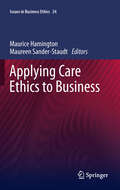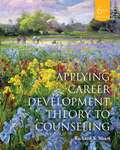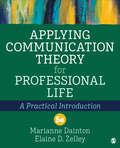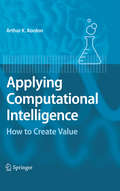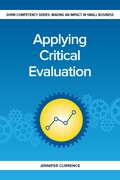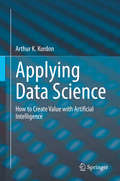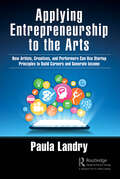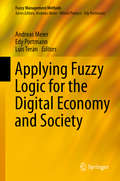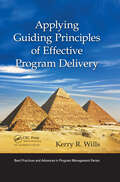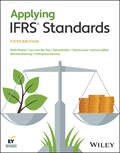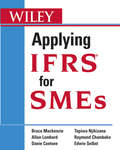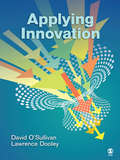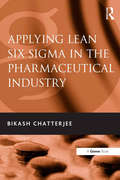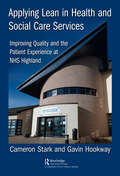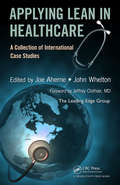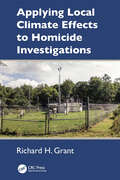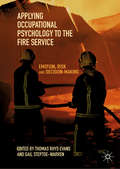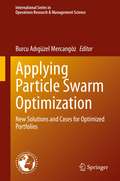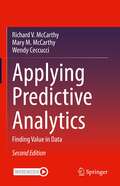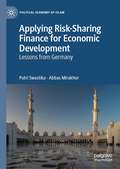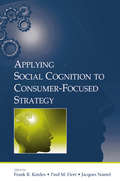- Table View
- List View
Applying Care Ethics to Business (Issues in Business Ethics #34)
by Maureen Sander-Staudt Maurice HamingtonApplying Care Ethics to Business is a multidisciplinary collection of original essays that explores the intersection between the burgeoning field of care ethics and business. Care ethics is an approach to morality that emphasizes relational, particularist, and affective dimensions of morality that evolved from feminist theory and today enjoys robust intellectual exploration. Care ethics emerged out of feminist theory in the 1980's and the greatest contribution to moral analysis among Women' Studies scholars. Today, feminists and non-feminist scholars are increasingly taking care ethics seriously. Applying care to the marketplace is a natural step in its maturity. Applying Care Ethics to Business is the first book-length analysis of business and economic cases and theories from the perspective of care theory. Furthermore, given economic turbulence and the resulting scrutiny of market practices, care ethics provides fresh and timely insight into ideal business values and commitments. In many ways, care ethics' emphasis upon connection and cooperation as well as the growth and well-being of the other make it appear to be the antithesis of the corporate character. Nevertheless, many contemporary theorists question if traditional moral approaches based on autonomous agents is adequate to address a shrinking and interconnected world--particularly one that is marked by global markets. Applying Care Ethics to Business offers a unique opportunity to rethink corporate responsibility and business ethics.
Applying Career Development Theory to Counseling 6th Edition
by Richard S. SharfA must-read for counselors in training, Sharf's APPLYING CAREER DEVELOPMENT THEORY TO COUNSELING, 6th Edition, shows you how to apply the principles of career development to a variety of counseling settings. This book is clearly written, filled with useful case examples, and includes integrated diversity coverage to give you the advantage in your course and your career.
Applying Communication Theory for Professional Life: A Practical Introduction
by Marianne Dainton Elaine D. ZelleyNow in its fifth edition, Applying Communication Theory for Professional Life is the first communication theory textbook to provide practical material for career-oriented students. Featuring new case studies, updated examples, and the latest research, authors Marianne Dainton and Elaine D. Zelley introduce communication theory in a way that helps students understand its importance to careers in communication and business. Real-world case studies within each chapters are designed for in-class use to illustrate the application of theory in a variety of professional settings. The Fifth edition features eight new theories, a new chapter on theories of strategic communication, and expanded discussions of mediated communication theories.
Applying Communication Theory for Professional Life: A Practical Introduction
by Marianne Dainton Elaine D. ZelleyNow in its fifth edition, Applying Communication Theory for Professional Life is the first communication theory textbook to provide practical material for career-oriented students. Featuring new case studies, updated examples, and the latest research, authors Marianne Dainton and Elaine D. Zelley introduce communication theory in a way that helps students understand its importance to careers in communication and business. Real-world case studies within each chapters are designed for in-class use to illustrate the application of theory in a variety of professional settings. The Fifth edition features eight new theories, a new chapter on theories of strategic communication, and expanded discussions of mediated communication theories.
Applying Computational Intelligence: How to Create Value
by Arthur KordonThe flow of academic ideas in the area of computational intelligence is impacting industrial practice at considerable speed. Practitioners face the challenge of tracking, understanding and applying the latest techniques, which often prove their value even before the underlying theories are fully understood. This book offers realistic guidelines on creating value from the application of computational intelligence methods. In Part I, the author offers simple explanations of the key computational intelligence technologies: fuzzy logic, neural networks, support vector machines, evolutionary computation, swarm intelligence, and intelligent agents. In Part II, he defines the typical business environment and analyzes the competitive advantages these techniques offer. In Part III, he introduces a methodology for effective real-world application of computational intelligence while minimizing development cost, and he outlines the critical, underestimated technology marketing efforts required. The methodology can improve the existing capabilities of Six Sigma, one of the most popular work processes in industry. Finally, in Part IV the author looks to technologies still in the research domain, such as perception-based computing, artificial immune systems, and systems with evolved structure, and he examines the future for computational intelligence applications while taking into account projected industrial needs. The author adopts a light tone in the book, visualizes many of the techniques and ideas, and supports the text with notes from successful implementations. The book is ideal for engineers implementing these techniques in the real world, managers charged with creating value and reducing costs in the related industries, and scientists in computational intelligence looking towards the application of their research.
Applying Critical Evaluation: Making an Impact in Small Business (Making an Impact in Small Business HR)
by Jennifer CurrenceHR professionals are constantly asked to make sound decisions with limited time and resources. Applying Critical Evaluation offers practical, ready-to-use guidance to help HR practitioners - especially in small businesses or departments of one - think strategically and drive better outcomes. Drawing from thought leadership and real-world examples, the book walks through every stage of the evaluation process, from gathering and interpreting data to proposing solutions and influencing decisions. Tools, worksheets and case studies support immediate implementation across a range of HR functions, from selecting an HRIS and identifying training programs to developing an onboarding process or proposing organizational restructuring. Whether you're refining an existing process or building one from scratch, this book is a trusted guide to becoming a more effective, analytical HR professional.
Applying Data Science and Analytics at P&G
by Srikant M. Datar Paul Hamilton Sarah MehtaSet in December 2019, this case explores how P&G has applied data science and analytics to cut costs and improve outcomes across its business units. The case provides an overview of P&G's approach to data management and governance, and reviews the challenges associated with changing long-established work processes within the company. It concludes by exploring four examples of how P&G has applied analytics to its businesses.
Applying Data Science: How to Create Value with Artificial Intelligence
by Arthur K. KordonThis book offers practical guidelines on creating value from the application of data science based on selected artificial intelligence methods. In Part I, the author introduces a problem-driven approach to implementing AI-based data science and offers practical explanations of key technologies: machine learning, deep learning, decision trees and random forests, evolutionary computation, swarm intelligence, and intelligent agents. In Part II, he describes the main steps in creating AI-based data science solutions for business problems, including problem knowledge acquisition, data preparation, data analysis, model development, and model deployment lifecycle. Finally, in Part III the author illustrates the power of AI-based data science with successful applications in manufacturing and business. He also shows how to introduce this technology in a business setting and guides the reader on how to build the appropriate infrastructure and develop the required skillsets. The book is ideal for data scientists who will implement the proposed methodology and techniques in their projects. It is also intended to help business leaders and entrepreneurs who want to create competitive advantage by using AI-based data science, as well as academics and students looking for an industrial view of this discipline.
Applying Entrepreneurship to the Arts: How Artists, Creatives, and Performers Can Use Startup Principles to Build Careers and Generate Income
by Paula LandryThis book puts successful startup tools in the hands of creators: performers, artists, entertainers, creatives, and media makers seeking to launch like a business and generate more income. Readers will learn essential entrepreneurial principles taught to founders in the startup community. Creatives who read this book will learn: How to launch their creative startups Ways to run and market their venture efficiently Effective methods to test new services, products, and experiences To incorporate their entire skill set in an authentic way That they can do all of this now, without business classes or special training With actionable information, real-world case studies as examples, and specific steps to build business acumen from an artistic perspective, this book puts entrepreneurial tools into the frameworks and mindsets of those working in creative fields. Paula Landry, MBA, is a creator, writer/filmmaker, and musician who has been teaching and coaching creatives for a decade, through undergraduate and graduate programs in New York City, as well as at various non-profits.
Applying Entrepreneurship to the Arts: How Artists, Creatives, and Performers Can Use Startup Principles to Build Careers and Generate Income
by Paula LandryThis book puts successful startup tools in the hands of creators: performers, artists, entertainers, creatives, and media makers seeking to launch like a business and generate more income.Readers will learn essential entrepreneurial principles taught to founders in the startup community. Creatives who read this book will learn: How to launch their creative startups Ways to run and market their venture efficiently Effective methods to test new services, products, and experiences To incorporate their entire skill set in an authentic way That they can do all of this now, without business classes or special training With actionable information, real-world case studies as examples, and specific steps to build business acumen from an artistic perspective, this book puts entrepreneurial tools into the frameworks and mindsets of those working in creative fields.Paula Landry, MBA, is a creator, writer/filmmaker, and musician who has been teaching and coaching creatives for a decade, through undergraduate and graduate programs in New York City, as well as at various non-profits.
Applying Fuzzy Logic for the Digital Economy and Society (Fuzzy Management Methods)
by Edy Portmann Andreas Meier Luis TeránThis edited book presents the state-of-the-art of applying fuzzy logic to managerial decision-making processes in areas such as fuzzy-based portfolio management, recommender systems, performance assessment and risk analysis, among others. Presenting the latest research, with a strong focus on applications and case studies, it is a valuable resource for researchers, practitioners, project leaders and managers wanting to apply or improve their fuzzy-based skills.
Applying Guiding Principles of Effective Program Delivery
by Kerry R. WillsWhile today's programs continue to grow in size and complexity, their success rates remain low. To manage programs effectively in this environment, project managers and program managers must take a consultative approach that applies a core set of guiding principles across every function of the program. This book explains what it means to take a consultative approach. Instead of focusing on specific program management techniques, it covers the guiding principles required to make those techniques effective-making it applicable to any program in any industry.
Applying IFRS Standards (Wiley Regulatory Reporting)
by Ruth Picker David Kolitz Gilad Livne Janice Loftus Leo van der Tas Miriam Koning Cathrynne ServiceA comprehensive IFRS practice resource from leading accounting authorities In the newly revised fifth edition of Applying IFRS® Standards, a team of accounting experts delivers a comprehensive practice resource designed for accountancy students and accounting practitioners seeking to better understand the complexities of International Financial Reporting Standards (IFRS). The book begins with an overview of the International Accounting Standards Board (IASB) and explains how it establishes accounting standards, before moving on to a discussion of the key concepts and applications of IFRS. It offers insights and examples sourced from the international business world and addresses the skills you need to apply the standards in real-world business environments. In addition to a comprehensive factual breakdown of the IFRS Standards, parts of the book are accompanied by an academic perspective, which offers key relevant research findings. Applying IFRS® Standards provides discussion questions, exercises, and references, as well as complimentary access to a companion website that contains additional chapters, instructor slides, test banks, more exercises, a solutions manual, and new IFRS Learning Resources. This is an essential learning tool for students and early-career accounting professionals, as well as a useful desk reference for established accounting practitioners.
Applying IFRS for SMEs
by Tapiwa Njikizana Danie Coetsee Bruce Mackenzie Allan Lombard Raymond ChambokoAn invaluable aid to companies and auditors involved in first-time adoption of the new SMEs standard Applying the IFRS for SMEs provides expert insights and explanations of the International Financial Reporting Standards (IFRS) for small and medium enterprises (SMEs) issued by the International Accounting Standards Board (IASB). This important book includes comprehensive coverage of this recently issued standard aimed at small and medium-sized businesses. Provides essential coverage for application of IFRS-now a necessity in the accounting world Includes Foreword by Paul Pacter, Director of Standards for SMEs, IASB Offers commentary on the theory in the standard, illustrative disclosures, comprehensive illustrative financial statements and comparisons to full IFRS Includes relevant real life worked out examples aimed at SMEs, plus summaries of important points The first book on how to apply the new SMEs standard, Applying the IFRS for SMEs is a must-have book for your small or medium-sized business.
Applying Innovation
by Lawrence Dooley David O′SullivanA step-by-step approach to applying high-impact innovation principles in any organizationInnovation is an important force in creating and sustaining organizational growth. Effective innovation can mean the difference between leading with a particular product, process, or service—and simply following the pack. Innovation transforms mediocre companies into world leaders and ordinary organizations into stimulating environments for employees.Applying Innovation combines the key ingredients from areas including innovation management, strategic planning, performance measurement, creativity, project portfolio management, performance appraisal, knowledge management, and teams to offer an easily applied recipe for enterprise growth. Authors David O′Sullivan and Lawrence Dooley map out the main concepts of the innovation process into a clear, understandable framework—the innovation funnel. Unlike other texts for this course, Applying Innovation goes beyond methodologies and checklists to offer an invaluable step-by-step approach to actually applying high-impact innovation in any organization using a knowledge management systems, whether for a boutique firm or one comprised of thousands of individuals. Key Features:Adopts a practical approach to overseeing innovation that focuses on useful tools and techniques rather than on theory and methodologiesOffers student activities within the text for immediate application of key concepts, reinforcing retention and comprehensionTeaches students to build and apply effective innovation management systems for any organization successfully, regardless of the firm′s size or structure Intended Audience:Applying Innovation is designed for undergraduate and graduate courses such as Innovation Management, Project Management, Strategic Planning, and Performance Management in fields of business, science, and engineering. This book appeals to instructors who want to reduce the "chalk and talk" and increase the hands-on practicality of their courses in innovation management.
Applying Lean Six Sigma in the Pharmaceutical Industry
by Bikash ChatterjeeBikash Chatterjee emphasizes the criticality of applying the principles of Lean and Six Sigma within the paradigm of the drug development process. His guide to operational excellence in the pharmaceutical and biotech industries is a focused summary of the application of Lean Six Sigma theory to the regulated life sciences. From molecule discovery to the application of PAT Applying Lean Six Sigma in the Pharmaceutical Industry will highlight the importance of framing these initiatives within the key deliverables of drug development manufacturing and quality. Challenging conventional wisdom the author offers a quality and efficiency perspective as a foundation for the principles of Quality by Design, PAT and the new philosophies underlying Process Validation. Each chapter includes discussion around the considerations for applying Lean manufacturing and Six Sigma principles and their tools, culminating in a case study to illustrate the application. The book is organized to reflect the major work centers involved in the drug development lifecycle. Each chapter is stand-alone but together they illustrate the necessary synergy between Lean, Six Sigma and compliance sensibilities required to be successful in the pharmaceutical industry. These design, manufacturing and management techniques are not without their challenges. Bikash Chatterjee's book offers the roadmap for an industry that is struggling to reinvent many of its development and business processes.
Applying Lean in Health and Social Care Services: Improving Quality and the Patient Experience at NHS Highland
by Cameron Stark Gavin HookwayOrganizations around the world are using Lean to redesign care and improve processes in a way that achieves and sustains meaningful results for patients, staff, physicians, and health systems. This book systematically describes how NHS Highland uses Lean principles and mindsets to improve safety, quality, access, and morale while reducing costs, and increasing capacity. Existing books often describe the gains obtained by using Lean methods, but often do not describe the underlying concepts and methods in details. Other books describe continuous improvement work, or specific techniques such as daily management in detail. This book seeks to occupy a middle space by providing an overview of the range of Lean ideas applicable to healthcare with sufficient examples and cases studies from NHS Highland and partner organizations so readers can see them in use and practice.
Applying Lean in Healthcare: A Collection of International Case Studies
by Joe Aherne John WheltonTypically entrenched and systemic, healthcare problems require the sort of comprehensive solutions that can only be addressed by a change in culture and a shift in thinking. Applying Lean in Healthcare: A Collection of International Case Studies demonstrates how honest appraisal, intelligent planning, and vigilant follow-up have led to dramatic imp
Applying Local Climate Effects to Homicide Investigations
by Richard H. GrantApplying Local Climate Effects to Homicide Investigation presents the concepts behind using local climate and weather records to enhance understanding of criminal cases. While sources of such local climate and weather information varies by country and regions, weather conditions are typically measured at airports or grassy areas as part of a national, regional, or state-wide networks using many different instruments.The information derived from such instruments and weather reporting services and agencies can inform and impact investigations, especially in the case of natural death or homicide cases. The determination of post-mortem interval (PMI) in homicide cases is often based on entomological or anthropological evidence in combination with local climate estimations. Determining the local climate conditions typically requires knowledge of the environmental conditions where the body is found and the conditions where the measurement record was made. Most people recognize that cities are hotter than the surrounding countryside and that lake and coastal shorelines are cooler than fields: all of these comprise local climates. The local climate where a corpse is discovered usually differs from where temperature and humidity measurements are made. Consequently, many investigators and forensic pathologists do not realize the influence that such local temperatures and humidity can have on post-mortem interval determinations.The book focuses on local climate conditions associated with the determination of post-mortem interval (PMI) and gives concepts behind adjusting climate information for local climates at the corpse. In addition, the book will present guidelines for crime scene investigators and lawyers to determine whether or not expert consultation is needed, and whether or not on-site measurements are needed. Most importantly, this book presents tools (data sources and modeling approaches) to guide forensic climatologists conducting forensic climatology work. It offers a basic, working understanding of the influence of the local environment on the local climate for forensic entomologists, forensic anthropologists, crime scene investigators, and lawyers. Numerous case studies are included throughout to show approaches, illustration decision points, and provide an understanding of the various impacts of regional and micro-climates upon decedents and their remains.
Applying Occupational Psychology to the Fire Service: Emotion, Risk and Decision-Making
by Gail Steptoe-Warren Thomas Rhys EvansApplying Occupational Psychology in the Fire Service: Emotion, Risk and Decision-Making provides readers with an overview of the latest research informing the policies, procedures and practices of those working on the ground in the UK Fire Service. Using best-practice principles and cutting-edge theory, the current text demonstrates how occupational psychology can be applied to fire services around the globe to improve individual, management, and organisational decisions. The authors aim to provide students, trainees, practitioners and fire personnel with a unique insight into a range of topics, including resilience, injury, work related wellbeing, community engagement as well as decision making and operational preparedness. This book represents a call to arms for more robust practices to support the Fire Service, highlighting the psychological factors involved in the firefighter occupation and paving the way towards a better understanding of emotion, risk, safety, and decision-making within the fire context.
Applying Particle Swarm Optimization: New Solutions and Cases for Optimized Portfolios (International Series in Operations Research & Management Science #306)
by Burcu Adıgüzel MercangözThis book explains the theoretical structure of particle swarm optimization (PSO) and focuses on the application of PSO to portfolio optimization problems. The general goal of portfolio optimization is to find a solution that provides the highest expected return at each level of portfolio risk. According to H. Markowitz’s portfolio selection theory, as new assets are added to an investment portfolio, the total risk of the portfolio’s decreases depending on the correlations of asset returns, while the expected return on the portfolio represents the weighted average of the expected returns for each asset.The book explains PSO in detail and demonstrates how to implement Markowitz’s portfolio optimization approach using PSO. In addition, it expands on the Markowitz model and seeks to improve the solution-finding process with the aid of various algorithms. In short, the book provides researchers, teachers, engineers, managers and practitioners with many tools they need to apply the PSO technique to portfolio optimization.
Applying Predictive Analytics: Finding Value in Data
by Richard V. McCarthy Mary M. McCarthy Wendy CeccucciThe new edition of this textbook presents a practical, updated approach to predictive analytics for classroom learning. The authors focus on using analytics to solve business problems and compares several different modeling techniques, all explained from examples using the SAS Enterprise Miner software. The authors demystify complex algorithms to show how they can be utilized and explained within the context of enhancing business opportunities. Each chapter includes an opening vignette that provides real-life examples of how business analytics have been used in various aspects of organizations to solve issues or improve their results. A running case provides an example of a how to build and analyze a complex analytics model and utilize it to predict future outcomes. The new edition includes chapters on clusters and associations and text mining to support predictive models. An additional case is also included that can be used with each chapter or as a semester project.
Applying Rawls in the Twenty-First Century
by Martin D. CarcieriJohn Rawls is the most influential political thinker of the twentieth century. Most of the scholarly literature on Rawls defends, critiques, or elaborates on some aspect of his theory. These writings are often valuable, yet this book goes beyond them. Like a few scholars, rather than debating whether and how Rawls got things right or wrong, Martin Carcieri take his well-defended principles of justice - especially the equal liberty, fair equality of opportunity, and difference principles atthe core of his theory - as given and apply them to aspects of four major, enduring, concrete domestic policy, ethical, and constitutional issues. These applications yield counter-intuitive implications that will challenge the ideological left and right alike, contributing to our understanding both of Rawls and of these issues. At the core, this book deepens our understanding of these issues and points the way toward rational, just policy reform.
Applying Risk-Sharing Finance for Economic Development: Lessons from Germany (Political Economy of Islam)
by Abbas Mirakhor Putri SwastikaThis book examines the application of risk-sharing finance as a national economic policy in history and how it stimulated economic recovery during a short period in Germany between 1933 and 1935. Economic history indicates that risk-sharing instruments have promoted socio-economic development in many parts of the world while risk-shifting methods have imposed huge socio-economic costs on many nations, leading to debt slavery on individual members. This book highlights lessons to be learned from history and argues that risk-sharing is a powerful tool for generating rapid economic recovery and resumption of growth.
Applying Social Cognition to Consumer-Focused Strategy (Advertising and Consumer Psychology Series)
by Paul M. Herr Frank R. Kardes Jacques NantelApplying Social Cognition to Consumer-Focused Strategy, a book in the Advertising and Consumer Psychology series sponsored by the Society for Consumer Psychology, focuses on the most important recent developments at the interface of social cognition and marketing, and develops integrative theoretical frameworks with rich practical implications. More specifically, the chapters offer a novel and thought-provoking perspective on consumer-focused strategy--or the effects of marketing stimuli and activities on an integrated system of consumer processes and responses.Divided into four parts, this book:*offers new perspectives on consumer information processing, selective or one sided information processing, and attribution theory;*discusses how asking questions in focus groups, surveys, and experiments leads consumers to create opinions that would not have occurred to them otherwise;*advances a new approach for modeling uncertainty and a new framework for thinking about uncertainty;*summarizes recent developments concerning the Implicit Association Test and their implications for branding strategy;*develops a new approach for analyzing the effects of intention on behavior and unplanned purchase behaviors;*discusses the devaluation effect and shows both how implementation intentions can be used to increase new product consumption and also how promotion versus prevention regulatory focus influences consumer preferences; and*focuses on consumer information processing and persuasion.The text is intended for advanced graduate students, academics, and practitioners who embrace cutting-edge paradigms and methodologies in social-cognitive consumer research.
